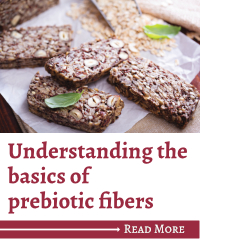Baked foods are naturally ideal platforms to deliver prebiotic ingredients. Consumers can associate some baked goods with healthful cues like fiber and whole grains.
Scott Turowski, technical sales manager, Sensus America Inc., said that perhaps the biggest benefit of prebiotics vs. probiotics in baking applications is their ability to withstand high temperatures.
Sensus offers a full line of chicory root fiber ingredients, also known as inulin, that provide a variety of functional benefits. Extensive clinical research has shown that chicory root fiber selectively stimulates the growth of the beneficial bifidobacteria, leading to decreases in potentially harmful bacteria. This positively impacts the overall gut microflora.
“Chicory root fiber can be easily incorporated into most baking applications,” Mr. Turowski said. “Functionally it has properties that enable it to be used as a replacement for sugar, fat or flour, providing the potential for additional health benefits. In addition to prebiotic and digestive health claims, it may also be possible to claim a ‘good’ or ‘excellent’ source of fiber depending on the usage level in the product.”
Trader Joe’s, Monrovia, Calif., makes such claims on its 12 Grain Mini Snack Crackers. The product’s packaging says “with inulin (prebiotic fiber) to help support the digestive tract” and “good source of fiber.” One serving, about 22 crackers, provides 3 grams of fiber.
Jon Peters, president of Beneo Inc., thinks prebiotic chicory root fiber will gain more consumer awareness in 2018 as a prebiotic and sugar replacer.
“With the current discussion about sugar reduction and less ‘added sugars’ ongoing, chicory root fibers offer a smart way to reduce or replace sugar while improving the nutritional profile by adding a prebiotic fiber,” Mr. Peters said. “It also helps to increase the fiber content of food and beverage products invisibly, which means that taste and texture remain the same or are even improved.”
 Beneo’s functional fibers — inulin and oligofructose — have been proven to support weight management and help the body absorb more calcium for stronger bones. In addition, Beneo’s functional fibers support a low glycemic diet. The European Food Safety Authority has positively evaluated claims that Beneo’s oligofructose varieties can be used in foods for reducing the post-prandial glycemic response.
Beneo’s functional fibers — inulin and oligofructose — have been proven to support weight management and help the body absorb more calcium for stronger bones. In addition, Beneo’s functional fibers support a low glycemic diet. The European Food Safety Authority has positively evaluated claims that Beneo’s oligofructose varieties can be used in foods for reducing the post-prandial glycemic response.
In baked foods and snack aisles, chicory root fiber is most often included in nutrition bars, cereals and bread.
“Given the ongoing pressure to reduce added sugars, bakeries are also looking at chicory root fiber for reduced-sugar cakes and cookies,” said Taylor Halstead, product manager for specialty carbohydrates, Cargill. While many bulking agents result in finished products with a crisper or firmer texture, chicory root fiber more closely mimics the texture of its full-sugar counterpart.
The list of specialty prebiotic fibers is growing, and their benefits are being explored in clinical studies.
Ingredion’s scFOS prebiotic, a short chain fructooligosaccharide, has different attributes and functionalities depending on the application. It has a clean, slightly sweet flavor (30% sweetness of sugar) and performs similarly to sugar at typical inclusion levels, and does not affect the taste of the end product. It’s soluble and does not contribute to viscosity, but it enhances flavors and can help round out the sweetness profile of high-intensity sweeteners.
“The scFOS’ short chain structure with glucose termination narrows the fermentation profile, and while the good bacteria preferentially ferment the scFOS, it does not allow it for use by pathogens,” said Patrick Luchsinger, marketing manager, nutrition, Ingredion, Inc. “Since pathogenic bacteria in the gut cannot ferment the scFOS, it fosters an environment that favors competitive inhibition of pathogens. When bifidobacteria species increase, pathogens tend to decrease in number.”
ADM offers a premier line of corn-based, soluble dietary fiber ingredients that have been scientifically proven as prebiotic fibers. Studies in humans and animals have shown the prebiotic helps maintain intestinal regularity and attenuate blood glucose levels, as well as help retain healthy serum triglycerides. Recent studies have also shown the prebiotic fiber can provide an increased feeling of satiety.
“It can be used in virtually any application, including bars, muffins, breads and cookies, and can be used to help solve a variety of formulation challenges such as reducing sugar and calories, meeting clean label goals, and helping promote digestive tract health,” said Doris Dougherty, technical services representative for ADM Nutrition. “It is a well-tolerated prebiotic fiber. It is highly soluble, sugar-like in functionality, low in viscosity, bland in flavor and stable in a variety of conditions.”
Michael Bond, global product line leader-fibers, DuPont Nutrition & Health, said to keep up the momentum, companies must create awareness and educate consumers on the benefits of prebiotics.
“Break the digestive health mindset for prebiotic claims and move to a broader base of health benefits such as improving resistance to infection, cognitive health, systemic inflammation/immune health, weight management, metabolic syndrome, enhanced nutrition and more,” he said.




